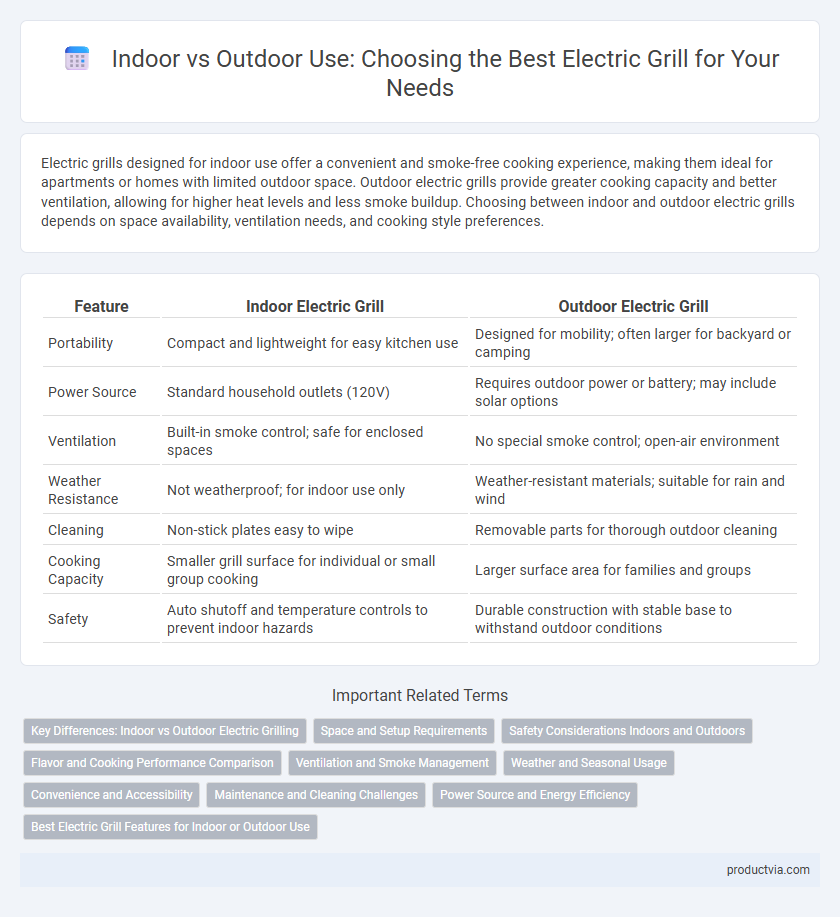Electric grills designed for indoor use offer a convenient and smoke-free cooking experience, making them ideal for apartments or homes with limited outdoor space. Outdoor electric grills provide greater cooking capacity and better ventilation, allowing for higher heat levels and less smoke buildup. Choosing between indoor and outdoor electric grills depends on space availability, ventilation needs, and cooking style preferences.
Table of Comparison
| Feature | Indoor Electric Grill | Outdoor Electric Grill |
|---|---|---|
| Portability | Compact and lightweight for easy kitchen use | Designed for mobility; often larger for backyard or camping |
| Power Source | Standard household outlets (120V) | Requires outdoor power or battery; may include solar options |
| Ventilation | Built-in smoke control; safe for enclosed spaces | No special smoke control; open-air environment |
| Weather Resistance | Not weatherproof; for indoor use only | Weather-resistant materials; suitable for rain and wind |
| Cleaning | Non-stick plates easy to wipe | Removable parts for thorough outdoor cleaning |
| Cooking Capacity | Smaller grill surface for individual or small group cooking | Larger surface area for families and groups |
| Safety | Auto shutoff and temperature controls to prevent indoor hazards | Durable construction with stable base to withstand outdoor conditions |
Key Differences: Indoor vs Outdoor Electric Grilling
Indoor electric grills offer compact designs with non-stick surfaces ideal for small kitchens and apartments, minimizing smoke and odor for convenient indoor use. Outdoor electric grills typically provide larger cooking surfaces with higher wattage for greater heat output and durability, suitable for open-air environments and social gatherings. Ventilation needs differ significantly; indoor electric grills feature integrated drip trays and smoke-reducing technology, whereas outdoor models leverage natural airflow to disperse smoke and odors effectively.
Space and Setup Requirements
Electric grills designed for indoor use typically feature compact sizes and easy-to-clean drip trays, making them ideal for small kitchens and limited countertop space. Outdoor electric grills often require more substantial setup with durable materials suited for weather resistance and may need dedicated space on patios or balconies. Both types offer quick assembly but vary significantly in spatial footprint and ventilation needs depending on the environment.
Safety Considerations Indoors and Outdoors
Electric grills designed for indoor use feature built-in safety mechanisms such as automatic shut-off and cool-touch exteriors to prevent fire hazards and burns in confined spaces. Outdoor electric grills benefit from better ventilation, reducing risks associated with smoke and carbon monoxide buildup, but require weather-resistant materials to ensure electrical safety in varying conditions. Proper placement away from water sources and combustible materials is critical for both indoor and outdoor use to minimize electrical shock and fire risks.
Flavor and Cooking Performance Comparison
Electric grills designed for indoor use often provide consistent temperature control and even heat distribution, enhancing cooking precision but sometimes lacking the smoky flavor characteristic of outdoor grilling. Outdoor electric grills can deliver stronger heat and allow for smoke-infused flavors by incorporating wood chips or charcoal alternatives, intensifying the taste profile. While indoor electric grills excel in convenience and ease of use, outdoor models generally outperform in achieving traditional grilled flavors and higher cooking temperatures.
Ventilation and Smoke Management
Electric grills designed for indoor use typically feature advanced ventilation systems and smoke management technologies to minimize indoor air pollution and prevent smoke buildup. Outdoor electric grills benefit from natural airflow, reducing the need for complex ventilation while effectively dispersing smoke. Proper ventilation in indoor electric grills ensures a safer cooking environment by filtering smoke and odors, which is less critical but still beneficial for outdoor electric grilling.
Weather and Seasonal Usage
Electric grills perform efficiently indoors regardless of weather conditions, offering consistent cooking results throughout the year. Outdoor use depends heavily on weather, with optimal performance in dry, mild conditions and potential limitations during rain or extreme cold. Seasonal usage favors indoor electric grilling during winter months and outdoor grilling during warmer seasons for enhanced ventilation and ambiance.
Convenience and Accessibility
Electric grills offer unparalleled convenience for indoor use, allowing quick and easy meal preparation without the need for charcoal or open flames. Their compact design and portability enhance accessibility, enabling users to grill year-round regardless of weather conditions or outdoor space limitations. Outdoor use of electric grills provides the benefit of smokeless cooking while maintaining the simplicity and ease of indoor models, making them versatile for patios, balconies, or camping environments.
Maintenance and Cleaning Challenges
Indoor electric grills require regular cleaning to prevent grease buildup and avoid smoke issues, with surfaces often designed for easy disassembly and dishwasher-safe parts. Outdoor electric grills face additional maintenance challenges like exposure to weather elements causing rust and dirt accumulation, necessitating protective covers and more frequent deep cleaning. Proper upkeep ensures efficient heating elements and prolongs the lifespan of both indoor and outdoor electric grills.
Power Source and Energy Efficiency
Electric grills designed for indoor use typically rely on standard household electrical outlets, offering consistent power supply without the need for fuel refills, which enhances convenience and energy efficiency. Outdoor electric grills may require access to portable power sources or longer extension cords, potentially limiting mobility but still maintaining efficient energy consumption compared to charcoal or gas grills. Indoor models often feature precise temperature control and faster heat-up times, optimizing electricity use for cooking smaller portions in enclosed spaces.
Best Electric Grill Features for Indoor or Outdoor Use
Electric grills designed for indoor use feature compact sizes, non-stick surfaces, and drip trays to manage grease, ensuring easy cleanup and smoke reduction ideal for confined spaces. Outdoor electric grills prioritize weather-resistant materials, higher wattage for faster heating, and larger cooking surfaces to accommodate group gatherings. Both types often include adjustable temperature controls and removable plates to enhance versatility and maintenance.
Indoor use vs outdoor use for electric grill Infographic

 productvia.com
productvia.com